A Rockin’ Christmas
Ken Neill
Published in Angler Magazine
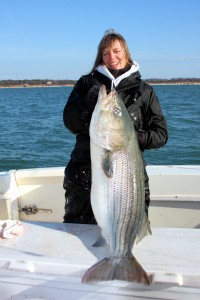 What a great time of the year! Holiday decorations are everywhere. Festive lights illuminate the night. Spiritual music fills the radio waves. Complete strangers are wishing each other a “Merry Christmas”. The kids are home from school and relatives are visiting. Can there be a better way to celebrate the holiday season than by gathering with family and friends out on the Chesapeake Bay? We are full of good cheer and big rockfish are here!
What a great time of the year! Holiday decorations are everywhere. Festive lights illuminate the night. Spiritual music fills the radio waves. Complete strangers are wishing each other a “Merry Christmas”. The kids are home from school and relatives are visiting. Can there be a better way to celebrate the holiday season than by gathering with family and friends out on the Chesapeake Bay? We are full of good cheer and big rockfish are here!
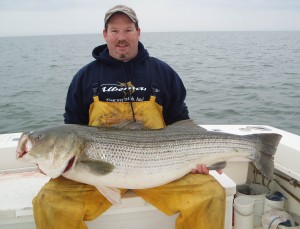 Striped bass are available in the Chesapeake Bay all year. You could say that they are born and raised here. The majority of the striped bass population calls the Chesapeake Bay home with smaller populations spawning in a few other watersheds. They stay in the bay until they grow up and join the coastal migration. By the time they are thirty inches long, most rockfish join the coastal migratory stock. Some larger fish will stay in the Chesapeake Bay throughout the year but the majority of large fish will leave our waters after spawning in the spring and move up the Atlantic seaboard to summer over off of the northeast coast. They work their way back down to us during the fall migration and will spend the winter here, gorging themselves until it is time to run back up the rivers for the spring spawn.
Striped bass are available in the Chesapeake Bay all year. You could say that they are born and raised here. The majority of the striped bass population calls the Chesapeake Bay home with smaller populations spawning in a few other watersheds. They stay in the bay until they grow up and join the coastal migration. By the time they are thirty inches long, most rockfish join the coastal migratory stock. Some larger fish will stay in the Chesapeake Bay throughout the year but the majority of large fish will leave our waters after spawning in the spring and move up the Atlantic seaboard to summer over off of the northeast coast. They work their way back down to us during the fall migration and will spend the winter here, gorging themselves until it is time to run back up the rivers for the spring spawn.
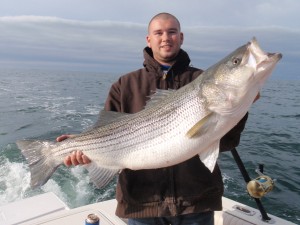 If your goal is to catch that rockfish of a lifetime, you want to be fishing Virginia’s portion of the Chesapeake Bay during the month of December. Fishing can be good throughout the fall, but for the really large fish December is the prime month and the second half of the month, Christmas time, can be magical. The striped bass season closes in the bay with the New Year. Depending on the severity of the winter, great catch and release fishing can continue through January. To keep fish, you will need to move out of the bay and fish along the oceanfront where the season remains open throughout the winter.
If your goal is to catch that rockfish of a lifetime, you want to be fishing Virginia’s portion of the Chesapeake Bay during the month of December. Fishing can be good throughout the fall, but for the really large fish December is the prime month and the second half of the month, Christmas time, can be magical. The striped bass season closes in the bay with the New Year. Depending on the severity of the winter, great catch and release fishing can continue through January. To keep fish, you will need to move out of the bay and fish along the oceanfront where the season remains open throughout the winter.
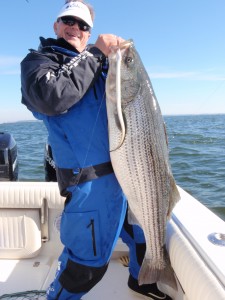 Rockfish can be found just about anywhere in the lower bay. There are areas that routinely produce the largest rockfish each December. These areas are where you will find the trophy hunters camped out and if you want that bragging board fish, you should be there too. The Chesapeake Bay Bridge Tunnel produces striped bass of mammoth proportions each December. The entire structure is not equal. Most of the larger fish will be caught from the 3rd island to the high rise area. Just outside the high rise, along Fisherman’s Island can be a good big-fish area as can be the water at Cape Henry. Up into the bay, the eastern side of the bay tends to produce more of the larger fish than the western. The deep-water channel that runs up the bay from off of the Concrete Ships on up past buoy 36A and on up to where it joins the main channel around buoy 38 and on up the bay. This deep water seems to be a highway for bait and the big rockfish that are looking for a meal. Find the schools of bunker, and fish there. Your trophy rockfish will be along soon.
Rockfish can be found just about anywhere in the lower bay. There are areas that routinely produce the largest rockfish each December. These areas are where you will find the trophy hunters camped out and if you want that bragging board fish, you should be there too. The Chesapeake Bay Bridge Tunnel produces striped bass of mammoth proportions each December. The entire structure is not equal. Most of the larger fish will be caught from the 3rd island to the high rise area. Just outside the high rise, along Fisherman’s Island can be a good big-fish area as can be the water at Cape Henry. Up into the bay, the eastern side of the bay tends to produce more of the larger fish than the western. The deep-water channel that runs up the bay from off of the Concrete Ships on up past buoy 36A and on up to where it joins the main channel around buoy 38 and on up the bay. This deep water seems to be a highway for bait and the big rockfish that are looking for a meal. Find the schools of bunker, and fish there. Your trophy rockfish will be along soon.
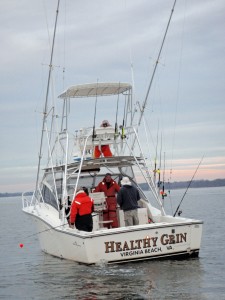 There are many techniques that can be used to catch rockfish. You can catch a big rockfish using any of them. Some techniques are more successful at consistently catching the largest fish. Open water trolling of large lures like jumbo-sized spoons and jigs can be very effective. A good big fish trolling set up is a large “Mojo” jig trolled near the bottom off of a three-way swivel. A trailing lure is pulled off of another arm of the swivel. This lure can be something like a big bunker spoon, a 13/0 Crippled Alewife spoon, or a big Storm-type lure.
There are many techniques that can be used to catch rockfish. You can catch a big rockfish using any of them. Some techniques are more successful at consistently catching the largest fish. Open water trolling of large lures like jumbo-sized spoons and jigs can be very effective. A good big fish trolling set up is a large “Mojo” jig trolled near the bottom off of a three-way swivel. A trailing lure is pulled off of another arm of the swivel. This lure can be something like a big bunker spoon, a 13/0 Crippled Alewife spoon, or a big Storm-type lure.
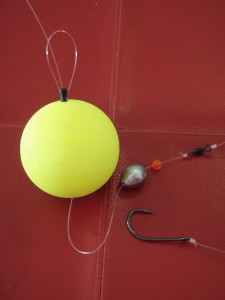 A very popular and successful method of targeting the largest rockfish during this time of year is to use live bait. Fishing with live spot and bunker can be very effective. More typically, the American eel is the bait of choice for serious trophy hunters. They can be slow-trolled, off of a three-way swivel along the pilings of the Chesapeake Bay Bridge Tunnel. They can be dropped down along the pilings on a fish finder rig.
A very popular and successful method of targeting the largest rockfish during this time of year is to use live bait. Fishing with live spot and bunker can be very effective. More typically, the American eel is the bait of choice for serious trophy hunters. They can be slow-trolled, off of a three-way swivel along the pilings of the Chesapeake Bay Bridge Tunnel. They can be dropped down along the pilings on a fish finder rig.
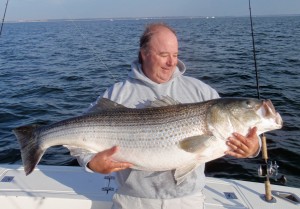 Commonly, boats will anchor up current of the structure and drift eels back to the bridge. These eels can be free-lined, suspended under bobbers, or worked backed with varying amounts of sinker weight to suspend the eels at various depths in the water column. This fishing is mostly done at night.
Commonly, boats will anchor up current of the structure and drift eels back to the bridge. These eels can be free-lined, suspended under bobbers, or worked backed with varying amounts of sinker weight to suspend the eels at various depths in the water column. This fishing is mostly done at night.
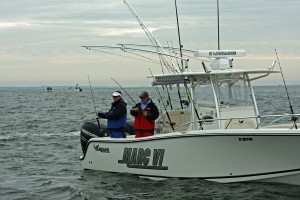 During the daytime, most “eelers” will be drifting in open water. They will have a “spread” of eels out: free-lines, down rods, and eels suspended under bobbers at various depths. Find the hot depth and put more of your eels at that level. Most boats will be drifting though you can anchor up on a good spot and feed your eels out into the current. Some boats will want more control over their drift. They will slow-troll their eels in a productive area using a combination of bobbers and side-planers to make their trolling spread.
During the daytime, most “eelers” will be drifting in open water. They will have a “spread” of eels out: free-lines, down rods, and eels suspended under bobbers at various depths. Find the hot depth and put more of your eels at that level. Most boats will be drifting though you can anchor up on a good spot and feed your eels out into the current. Some boats will want more control over their drift. They will slow-troll their eels in a productive area using a combination of bobbers and side-planers to make their trolling spread.
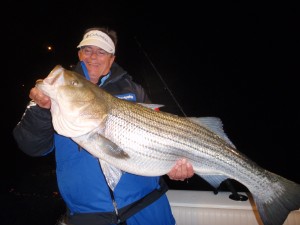 Whichever technique you prefer to use, December is the prime time to catch a trophy rockfish. Give yourself a Christmas present and go out and catch a big one!
Whichever technique you prefer to use, December is the prime time to catch a trophy rockfish. Give yourself a Christmas present and go out and catch a big one!
